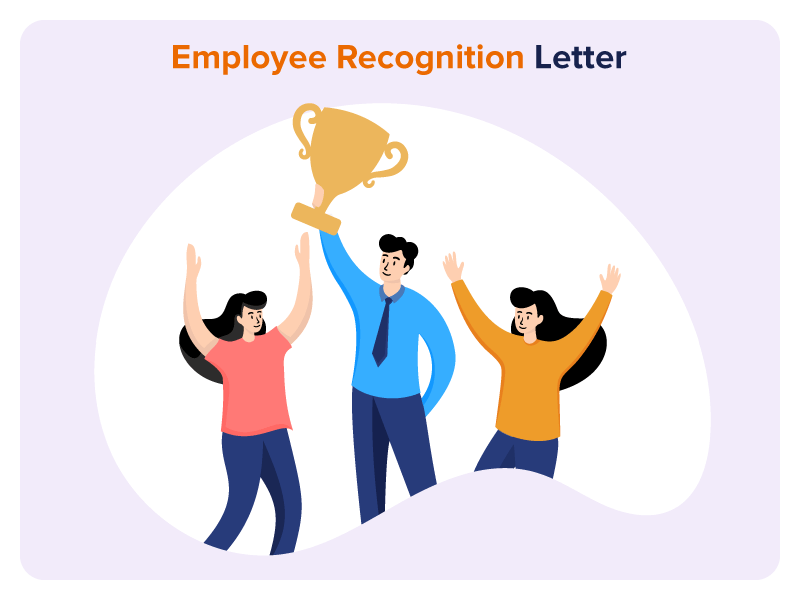Employee Recognition Letter Sample, Template and Example

Download Employee Recognition Letter Word Format For Free
Table of Contents
In the fast-paced environment of today’s corporate world, organisations are realising the value of showing employees appreciation. Beyond simple praise, employee recognition acts as a catalyst for engagement, motivation, and the development of a positive workplace culture. By recognising employee accomplishments, companies foster an environment that not only raises morale but also promotes continual development.
In this blog, we will explore why employee recognition is important, how to write an employee recognition letter and things to include in it, along with a sample for your reference.
What is an Employee Recognition Letter?
An employee recognition letter is a formal written letter that expresses acknowledgement, appreciation and gratitude for their exceptional performance in the organization. It acts as a tangible way to recognize and appreciate employees’ hard work that brought a positive impact within the organization. A recognition letter will highlight the accomplishments, efforts and milestones that employees have attained.
The purpose of an employee recognition letter is not only to express appreciation but also to motivate and inspire the recipient and others within the organization. By publicly acknowledging and celebrating outstanding performance, these letters reinforce positive behaviours, boost morale, and create a culture of recognition and appreciation.

Why is an Employee Recognition Letter Important
Here are some of the reasons why an employee recognition letter becomes important:
1. Boosts Motivation
Giving employees a formal letter of appreciation and recognizing their efforts can boost their motivation and morale. It shows that the company values employees’ efforts, takes consideration and takes out the time to encourage them.
2. Increases Retention
If employees are appreciated and valued, they are more likely to stay with the organisation. Giving employees a letter of appreciation improves the working environment, promotes employee loyalty, and raises retention rates.
3. Enhances Performances
Making efforts to recognize employees’ contributions will bring betterment to their performances. It will encourage employees to continue to perform at a higher level.
4. Reinforces Company Culture
Providing recognition letters to employees will help reinforce the company’s culture and values. Highlighting the specific behaviours and actions of employees in the letter can serve as a powerful tool for promoting desired behaviours and reinforcing company culture.

Types of Employee Recognition Letter
Employee recognition letters come in various forms, to suit different occasions and their formality levels. Understanding the different types can help you choose the most appropriate format for recognizing your employees’ achievements. The two main categories of employee recognition letters are formal and informal.
1. Formal Recognition Letters
Typically, formal recognition letters are used for important achievements or milestones which require a more formal and structured approach. These letters are frequently used for employee promotions, company-wide appreciation, exceptional work, and years of service.
You can have several kinds of formal recognition letters, such as:
Promotion Letters: Recognizing employees who have been promoted to higher positions within the organization.
Achievement Letters: Acknowledging an employee’s successes, such as meeting sales goals, finishing a challenging project, or winning an award.
Years of Service Letters: Letters praising an employee’s dedication towards the organization over an extended period of time, such as between five and ten years.
2. Informal Recognition Letters
Informal recognition letters are more casual and can be used for a wide range of accomplishments, big or small. These letters are often used as personal statements of appreciation for the employee’s consistent efforts, teamwork, or particular accomplishments. Informal letters of acknowledgment give supervisors and peers a more casual, personalized way to show appreciation and reward good performance.
Examples of informal recognition letters include:
Thank You Letters: Expressing gratitude for a job well done, going above and beyond, or helping a colleague.
Teamwork Appreciation Letters: Recognizing collaboration, cooperation, and teamwork efforts that contribute to the overall success of a project or department.
Specific Contribution Letters: Acknowledging employees for specific accomplishments or actions that had a positive impact on the team or organization.
Knowing the difference between formal and informal recognition letters can help you customize your message and tone as per the situation and the needed level of formality. Both kinds of letters are essential for encouraging an appreciation culture and encouraging employees to keep up their outstanding work.
Things to Include in Employee Recognition Letter
Look at the things that are required to be added to the employee recognition letter:
1. Employees Name and Designation
Address the employee by their full name at the beginning of the letter, along with mentioning their position within the company. This approach shows that the recognition is meant exclusively for the employee receiving it and adds a sense of sincerity.
2. Departments Name and Employees’ Duties
Mention the employee’s connection with the department or team in only a few words. This brings attention to the employee position within the greater organizational structure and highlights the importance of their contributions within their particular field of expertise. Additionally, briefly outline any essential tasks or responsibilities related with their job to highlight the importance of their achievements.
3. Appreciation Statement
Express the employee your sincere gratitude and appreciation. To express the value they add to the organization, use motivating and uplifting language. Highlight any particular characteristics that set them apart, such as their extraordinary efforts or dedication. Sincere and genuine remarks of appreciation will help the employee feel valued and acknowledged.
4. Reason for Recognition
Explain why the employee is being recognised in detail. Name the accomplishment, and outstanding performance which caught the organization’s attention. Be precise and give particular examples to highlight the effects in their work. This section helps the employee understand why they are being recognized which also highlights the value of the employee’s contributions.
5. Changes in Salary (if any)
Mention the details of the changes in salary if the recognition comes along with a bonus or salary increase. Specify the new salary or bonus amount as well as any further relevant information, such as the start date. The organization’s dedication to monetarily rewarding and recognising great performance is made clear in this section.
6. Time of Recognition
Specify the precise day or time that the employee’s accomplishments were noticed and acknowledged. This increases the sense of context and supports how timely the recognition was. Additionally, it enables the worker to take account of their achievements throughout that time period and experience feelings of pride and fulfillment.
7. Congratulate Again
Repeat your congratulations to the employee at the end of the letter. Emphasize your gratitude for their efforts and your belief in their future success. This final act of support and encouragement makes a favorable impression and inspires the employee to keep up their excellent work.
Tips to Write Recognition Letter
Here are some tips to write the recognition letter in a better way:
1. Be Honest and Specific
The main purpose of the recognition letter is to thank the employee for their contribution and motivate them to work the same way in future. Therefore this should be sincere, honest and specific about their work done.
2. Express Gratitude
Gratitude for their efforts and commitment is essential. This not only inspires employees to continue their efforts but also shows recognition.
3. Mindful Opening and Body
To ensure professionalism, it’s important to be mindful of the tone throughout the letter, and especially in the opening sentence and the body. Always, start the letter with a warm greeting and in the body mention the employee’s accomplishments and its positive impact on the company.
4. Mention Future Possibilities
If possible try to mention the employee’s future possibility of promotion. Mentioning the future of employees in the organization will again bring excitement and motivation to the employee.
5. Appropriate Tone in the Closing
Finish the letter with a positive, optimistic tone. Thank you again, and then sign off with your name.
Best Practices for Recognizing Employees
Building a healthy work environment and increasing employee engagement requires the implementation of efficient employee recognition methods. To make sure that your recognition efforts have a long-lasting effect, take into account the following recommended practices:
1. Time and Frequency of Recognition
To maximize the impact of employee accomplishments, acknowledge them as soon as possible. Recognise exceptional work, achievements, or efforts as they happen. Additionally, make sure that recognising others is a daily routine rather than a one-time occurrence. Celebrate accomplishments both big and small frequently to keep an appreciation-based culture alive.
2. Public and Private Recognition
Depending on the nature of the achievement and the employee’s preferences, choose the best location for the award. Public recognition, like appreciating during team meetings or company-wide activities, can improve morale and foster a sense of pride. To retain their comfort level, some employees might prefer receiving private recognition. Respect each person’s preferences and modify your strategy as necessary.
3. Aligning Recognition with Company Values
Make sure that any recognition represents the fundamental values and ideal behaviors of your organization. Rewarding actions that contribute to the company’s performance should be connected to its values and objectives. By enhancing the link between rewards and the overall organizational culture, this alignment encourages consistency and promotes the appropriate behaviors.
4. Communicating the Impact
Explain the importance of the acknowledged employee’s accomplishments in a simple manner. Describe how their contributions have benefited the group, division, or organization. Employees are inspired to keep aiming for excellence by making them aware of the significance of their job.
5. Leadership Involvement
It is essential that leaders participate in recognition activities. It sends a powerful message about the organization’s efforts to value its employees when leaders actively participate in recognising and appreciating employees. Leaders can set a good example by promoting the value of acknowledgment and making it an integral part of their interactions.
By implementing these best practices into execution, you can develop an effective system for employee recognition that builds a culture of appreciation and excellent performance while fostering a good work environment.

FAQs
1. Who Should Write an Employee Recognition Letter?
Managers, team lead, or human resources personnel commonly compose letters of appreciation for their employees. The letter must be written by someone who is qualified to evaluate the employee’s performance and has direct experience of their achievements. This strengthens the recognition letter’s legitimacy and reliability.
2. In What Ways does the Employee Recognition Letter Positively Impact the Organization?
In several ways, the employee recognition letter can bring a positive impact on the organization:
- Boosting employee morale, motivation, and job satisfaction.
- Fostering a culture of appreciation, recognition, and gratitude.
- Increasing employee engagement and productivity.
- Improving employee retention by making individuals feel valued and appreciated.
3. In What Ways does an Employee Recognition Letter be Delivered?
Depending on the practices followed by the organization, the letter can be sent as a printed letter, presented during a team meeting or employee gathering, or delivered electronically via email or internal communication platforms.
4. Is it Required to Include Specific Achievements in the Letter?
It is highly recommended and advantageous for a number of reasons to mention particular achievements in an employee recognition letter. Although not being a strict requirement, mentioning achievements gives the acknowledgment additional meaning and authenticity.
5. Should Employers Provide Physical or Digital Employee Recognition Letters?
When deciding whether to use a physical or digital employee recognition letter, factors like accessibility, convenience, cost, personalisation, cultural preferences, and privacy regulations should be taken into account. Giving employees the choice to select their preferred format would allow for a more personalized approach to recognition.
6. How Long Should an Employee Recognition Letter be?
An employee appreciation letter should be concise and to the point while communicating the relevant information and gratitude. As per general guidelines the letter can be from a few paragraphs to a page long.

Modernize your HR tasks with factoHR today
Experience the digitalization of everyday business activities with factoHR's modern and compatible solutions for every need.

© 2025 Copyright factoHR

